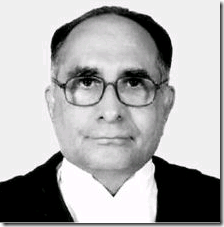
For example, Kapadia’s immediate predecessor K. G. Balakrishnan spent more than three years in the CJI chair and attracted significant controversy, criticism and a Central Bureau of Investigation (CBI) probe. Kapadia, by contrast, is unimpeachable by nearly all accounts.
“The main thing (Kapadia) had was that at a time when things were really getting bad, there was one man whose integrity could not be doubted at all,” commented one senior counsel.
Kapadia’s integrity is almost as legendary as his personal history that seems written for an Indian audience.
Born into a poor Parsi family just after India’s independence, he later worked as a peon-level employee in Bombay, learned to love the law, lunched on roasted channa at Mumbai’s Flora Fountain near the Bombay high court, and rose and rose through inhumanly hard work to became arguably one of India’s most influential men of the last two years – a story that was told beautifully by Forbes last month.
Post-retirement, Kapadia apparently doesn’t plan to be appointed into any post by the government as several other ex-apex court judges have been, according to Supreme Court lawyers. Instead, he is generally believed to want to return to Mumbai and work as an arbitrator - a highly lucrative career option for retired judges, particularly for those with his skill sets, and a fitting coda to his remarkable story.
Judicial discretion
The timing of Kapadia’s ascent was nearly perfect, coinciding with India’s post-liberalization transition from a system where discretion and the license raj ruled supreme to a more Western, rules-based economy. In such a system the rule of law rose beyond a jurisprudential concept to become a practical driver of economic growth, and the Supreme Court and its judges would be its captains.
In cases such as the 2G cases, the Vodafone case and the Sahara case, the Kapadia-era Supreme Court has arguably laid down the law for both the government and India Inc - no matter what the stakes, the parties in question or their market capitalization, no matter what spectres or threats of future chaos are raised, the Supreme Court will enforce the rule of law at all costs.
Last Saturday Kapadia confirmed as much at a conference on economic growth and the corporate environment alongside his successor, chief justice designate Altamas Kabir, and Prime Minister Manmohan Singh.
Kapadia said that only the rule of law could ensure a “minimum standard of fairness” as the “single largest” stimulant factor to economic growth rather than an impediment, according to The Hindu.
Kapadia also applauded the Government’s announcement the previous day to liberalize foreign direct investment (FDI) in supermarkets and the aviation sector economic reforms, which could avert “doomsday” by encouraging investment and fostering jobs growth, according to the Mail Today.
This was a rare public statement outside of court that went beyond Kapadia’s thoughts about judgeship by the famously media shy CJI (though media shyness risks misrepresenting his categorical self-imposed ban on being interviewed by media; his office did not respond to emails seeking comments.
But hints of the new Supreme Court philosophy were also obvious in Kapadia’s court.
The 6 September 2012 decision of the five-judge constitution bench headed by Kapadia on arbitration law, overruled the so-called Bhatia International case that had long spooked foreign investors and companies from settling disputes via arbitration with Indian companies, since Indian courts would stall arbitrations with their intervention.
And in his Vodafone income tax judgment, Kapadia stated his philosophy even more clearly: “FDI flows towards location with a strong governance infrastructure which includes enactment of laws and how well the legal system works. Certainty is integral to rule of law. Certainty and stability form the basic foundation of any fiscal system.”
Zodiac
That case was another example of how Kapadia’s star was perfectly aligned not just in terms of timing but also his interests: Kapadia’s tax law expertise is generally acknowledged as having no equals in the Indian bench.
At stake in the Vodafone case, notwithstanding later retrospective government legislation seeking to undo the judgment, were billions of dollars lost to either a foreign company or the government coffers, and it was quickly touted as one of India’s most important foreign investment-related disputes of recent years. But for many by-now jaded citizens, it would have been hard not to be suspicious of any human sitting judgment in such a case.
One lawyer, M. L. Sharma, attempted to draw a tenuous link between Kapadia and his son, who joined Ernst & Young one year after a different department of the firm had worked on the Vodafone-Hutchison deal. Sharma was fined Rs 50,000 by two other Supreme Court justices for the “frivolous” claim, though he tried for a second bite at proving potential Kapadia bias in another case because Kapadia’s son-in-law worked with a Tata group company.
A few other judges could have wavered under such attacks, however frivolous. Not so Kapadia.
Judicially, he may be remembered for several other tax judgments and asides from just economics, Kapadia also passed down the judgment upholding the constitutional validity of the revolutionary Right to Education Act. Less favourably, perhaps, the constitution bench hearing into regulating media reporting of court cases attracted flak not just from journalists but also from several advocates.
The boss
That said, judging the law is only half the job of a Chief Justice of India, who is nominally entrusted with managing India’s sprawling court system that comes loaded with more than 3 crores pending cases and the baggage of institutional and historical inefficiencies.
According to the pendency statistics, Kapadia did not book a success. When he took office in April 2010 a total of 55,018 were pending in the Supreme Court. This increased by nearly 16% until August 2012, when 63,749 cases are pending, of which 42,583 have been on the books for more than one year. The numbers in the lower courts too, which in fairness are not directly under Kapadia’s control, continued increasing.
One senior counsel claimed that it would be unfair to blame the outgoing CJI for this, however. “It really can’t be solved by any chief justice,” he said, adding that it is an inherent flaw in the system where any case can reach the apex court via special leave petitions (SLP) and there are no set hearing dates. And the lower courts are practically under the day-to-day supervision of the high courts.
“(Kapadia) can put the fear of god into people and things like that, but the country’s so big and there are so many courts, how much can the Chief Justice of India really do?” asked the advocate.
Kapadia certainly tried to impose discipline in his own backyard, such as by restricting advocates trying to leapfrog cases out of their scheduled order in his own court.
Cash register
Corruption in the Supreme Court registry has decreased significantly in Kapadia’s tenure, according to several advocates. “Previously somebody could try and have a matter fixed before a particular bench,” said one, or files could become lost or matters could get delayed.
Kapadia fixed this through sheer force of personality and hard work, poring over the list of the next day’s hearings with a fine tooth comb. “People in the registry were in terror of him,” recounted one advocate about how the chief managed to stem the registry’s indiscretions.
But in the lower court registries, it is still business as usual and a larger problem than it ever was at the apex court, claimed several lawyers.
The flipside of the chief’s campaign was a letter sent to Kapadia in June by the Supreme Court Advocates On Record (AOR) Association (SCAORA), complaining that the registry now suffered from “bottlenecks created by one sided decisions of the registry”. The AORs blamed this on a “communication gap” between the bench and the bar at an “institutional level”.
In a telling anecdote about Kapadia’s top-down management style, the SCAORA head’s letter noted that “members have observed with dismay and due respect that Your Lordship did not stay even for a minute for tea after finishing of the function or Farewell Parties for retiring Judges. It is respectfully suggested the open interaction on such occasions where there can be free interaction of ideas in the interest of the institution need not and ought not to be avoided”.
A similar communication gap is also said to have widened within the bench itself, according to several advocates, with the collegium of senior-most judges having failed to agree on any new appointments to the Supreme Court bench since May. With the recent retirement of Justice Deepak Verma, the apex court headcount would drop to 25 after Kapadia’s retirement – six below the sanctioned strength of 31, and four fewer than at the beginning of 2011.
Tenacious tenure
At 871 days or two years and just over four months, Kapadia has enjoyed one of the longest tenures in recent history as India’s judicial chief – in 27 years only three have served for longer.
However, due to the intricacies of the judicial appointment and retirement process, Kapadia’s successors Kabir and Justice P Sathasivam are scheduled to head the country’s judiciary for only around nine months each, which will barely be enough time to make a dent.
“The fact of the matter is that (Kapadia) had the longest tenure but I don’t think he has done anything significant to use that tenure to make (lasting changes),” said one Supreme Court advocate, adding that a lot would depend on the personality of the next CJIs and whether they can continue the micromanagement of the registry as Kapadia had done.
Kapadia should have worked on computerizing the apex court by creating a full e-court, as the Delhi high court has started doing, said the advocate, although another lawyer speculated that this would take at least a decade because the older generation of judges would never be comfortable with using information technology in the courtroom. Kabir may yet end up proving both of them wrong.
The problem of Supreme Court judges’ short terms, is of course institutional, and something that might only be fixed by raising the retirement age, though that carries with it the risk that someone less administratively gifted than Kapadia could run the place into a quagmire over a longer time.
Without doubt, Kapadia enjoys huge respect and senior lawyers and former colleagues have been quick to heap praise on him in a large number of recent published profiles.
But will he be remembered in the pantheon of India’s greatest CJIs? “No way near,” said one senior counsel, citing M. N. Venkatachaliah as a recent example of an all-round truly great CJI.
However, very few would disagree that Kapadia was the right man with the right job, who, crucially, was there at the right time.
Further reading on and around Kapadia:
- Kapadia, from appointment until today, as covered by Legally India and others
- India, meet your future boss: CJI-to-be Altamas Kabir vs SH Kapadia (profiled by Court Witness)
- Academics comment on case pendency: Lawyers are to blame but Kapadia’s cure worse than disease?
- Legally India’s Pendency Project
- SH Kapadia mid-term appraisal: Crying Room Hercules cleans SC stables after dirty decades

A shorter version of this article appeared in today’s Mint. Legally India has an exclusive content partnership with Mint, which will feature the latest legal news and analysis every fortnight on Fridays in its print and web editions.
threads most popular
thread most upvoted
comment newest
first oldest
first
andamanchronicle.com/content/view/4444/27/
See:
www.indianexpress.com/news/supreme-but-not-superior/583098/
www.indianexpress.com/news/with-sense-of-hurt-chief-justice-a-p-shah-author-of-landmark-rulings-retires-from-hc/578909/
www.ndtv.com/article/india/justice-a-p-shah-retires-hurt-16247
In fact the first link here, is a article written by the son of a sitting HC judge. So you know, this is a sentiment shared by even the Bench.
Pity same thing cannot be said for Altamas Kabir.
threads most popular
thread most upvoted
comment newest
first oldest
first